
 News
News
An algorithm to predict psychotic illnesses
Schematic representation of longitudinal network analyses applied to developmental psychiatry. Networks are reconstructed by calculating correlations between different symptoms, both at each assessment and over time. This allows the risk of developing a psychotic disorder in adolescence to be estimated and the most important targets for treatment to be identified. © UNIGE
Teams from the UNIGE and EPFL have used for the first time the method of longitudinal network analysis applied to children, in order to detect the symptoms that herald the development of psychotic illness in the future.
One third of children with a microdeletion of chromosome 22 will later develop a psychotic illness such as schizophrenia. But how do we know which of these children might be affected? Today, various studies have contributed to the understanding of the neurobiological mechanisms that are associated with the development of psychotic illnesses. The problem is that the ability to identify those at risk and adapt their treatment accordingly remains limited. Indeed, many variables – other than neurobiological – contribute to their development. This is why a team from the University of Geneva (UNIGE) has joined forces with a team from the EPFL to use in a longitudinal manner an artificial intelligence tool: the network analysis method. This algorithm correlates many variables from different backgrounds – neurobiological, psychological, cognitive, etc. – over a period of twenty years, in order to determine which current symptoms are predictive of a psychotic illness in the child’s future developmental trajectory. These results, to be read in the journal eLife, will enable early treatment of children deemed to be at risk of developing psychological disorders, with the aim of preventing or even avoiding them.